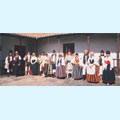CLOTHING CUSTOMS.
 The first glimmerings of the local clothing customs originated even before the Muslim presence in the VIII century. Evolution of clothing articles happened simultaneously together with the incipient social development, up until the XVIII century.
The first glimmerings of the local clothing customs originated even before the Muslim presence in the VIII century. Evolution of clothing articles happened simultaneously together with the incipient social development, up until the XVIII century.
The Arabs left their mark on clothing customs in the Canary Islands by contributing the industry of silk as well as cotton cultivation. Little by little, the seaman’s cap, backcombs, capes and cloaks gained a foothold as part of the clothing. Meanwhile, the Arabs introduced shirts, under drawers, lace headscarves, gowns, headdresses, sashes and headscarves.
Even more ancient are the hats, hoods, leggings, jerkin waist or bodice, skirts, slips and aprons, as well as shoes, jackets, trousers and petticoats.
Today, ritual costumes are used for special activities, such as those with religious or profane characteristics.
In order to face daily life, people in the Canary Islands maintain typical costumes or clothes according to the climate, always challenging modern trends.